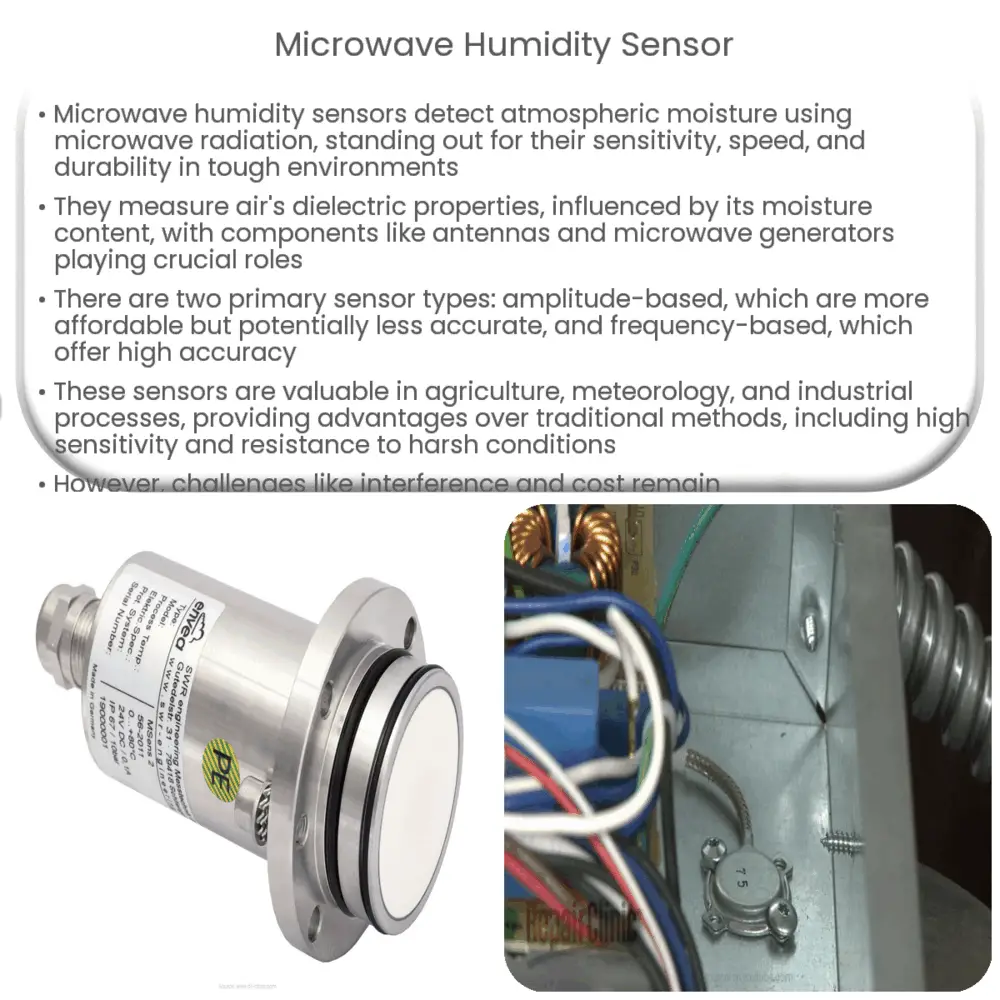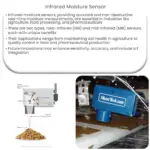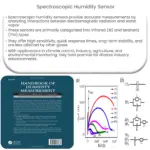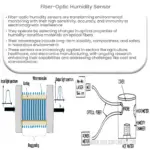Microwave humidity sensors are a relatively new and innovative technology in the field of environmental monitoring. These sensors detect and measure the amount of moisture present in the atmosphere using microwave radiation.

Microwave Humidity Sensor: An Overview
Introduction
Microwave humidity sensors are a relatively new and innovative technology in the field of environmental monitoring. These sensors detect and measure the amount of moisture present in the atmosphere using microwave radiation. Their growing popularity stems from their high sensitivity, fast response time, and ability to operate in harsh environments. In this article, we will discuss the principles behind microwave humidity sensors, their applications, and the benefits they provide.
Principles of Operation
Microwave humidity sensors operate by measuring the dielectric properties of the air, which are directly related to its moisture content. When microwave radiation is emitted, it interacts with water molecules in the atmosphere, causing a change in the radiation’s properties. These changes can be detected and measured, providing a means to determine the humidity level in the surrounding environment.
The key components of a microwave humidity sensor include an antenna for transmitting and receiving microwave signals, a microwave generator, a detector, and a processing unit. The microwave generator produces a continuous wave of microwave radiation, which is transmitted into the air by the antenna. As the radiation passes through the atmosphere, it interacts with water molecules, resulting in a change in the radiation’s amplitude, phase, or frequency. The antenna then receives the altered microwave signal, and the detector measures the changes. Finally, the processing unit analyzes the data and calculates the humidity level.
Types of Microwave Humidity Sensors
There are two primary types of microwave humidity sensors, based on the method used to measure the changes in microwave radiation: amplitude-based and frequency-based sensors.
Amplitude-based Sensors
Amplitude-based microwave humidity sensors measure the change in amplitude of the microwave signal after it interacts with water molecules in the air. As the humidity level increases, the amplitude of the received signal decreases, providing a means to determine the moisture content of the environment. These sensors offer a simple and cost-effective solution for humidity measurement, but they can be susceptible to interference from other sources of microwave radiation, limiting their accuracy in certain situations.
Frequency-based Sensors
Frequency-based microwave humidity sensors measure the change in frequency of the microwave signal after it interacts with water molecules. The frequency shift is directly proportional to the humidity level, providing a highly accurate and reliable means to measure moisture content. These sensors are less susceptible to interference from other sources of microwave radiation, but they typically require more complex and expensive components to operate.
Applications
Microwave humidity sensors find applications in a wide range of industries, including agriculture, meteorology, environmental monitoring, and industrial processes. Some specific uses include:
- Weather stations: Monitoring humidity levels is crucial for accurate weather forecasting and understanding local climate conditions.
- Agriculture: Farmers can use microwave humidity sensors to monitor soil moisture and optimize irrigation practices, reducing water waste and improving crop yields.
- Greenhouses: Controlling humidity levels in greenhouses is essential for maintaining plant health and preventing the growth of mold and other pathogens.
- Industrial processes: Many manufacturing processes require precise control of humidity levels to ensure product quality and prevent damage to sensitive equipment.
Advantages of Microwave Humidity Sensors
Microwave humidity sensors offer several advantages over traditional humidity sensing technologies, such as capacitive, resistive, and optical sensors. These benefits include:
- High sensitivity: Microwave sensors can detect minute changes in humidity levels, providing accurate and reliable measurements even in low-humidity environments.
- Fast response time: These sensors respond quickly to changes in humidity, allowing for real-time monitoring and control of environmental conditions.
- Wide operating range: Microwave humidity sensors can operate over a broad range of humidity levels, making them suitable for use in diverse environments and applications.
- Resistance to harsh environments: Unlike other types of humidity sensors, microwave sensors are not affected by dust, dirt, or corrosive gases, enabling them to perform reliably in challenging conditions.
- Non-contact measurement: Microwave sensors measure humidity levels without coming into direct contact with the air or surfaces, reducing the risk of contamination and wear.
Challenges and Future Developments
Despite their numerous advantages, microwave humidity sensors also face some challenges that need to be addressed to further enhance their performance and expand their applications. These challenges include:
- Interference from other microwave sources: Microwave sensors can be susceptible to interference from other sources of microwave radiation, such as Wi-Fi routers and microwave ovens. Advanced signal processing techniques and shielding materials are being developed to mitigate this issue.
- Size and power consumption: The components used in microwave humidity sensors can be relatively large and consume more power than other types of sensors. Miniaturization and energy-efficient designs are critical for enabling the use of these sensors in portable and battery-powered devices.
- Cost: The complex components and manufacturing processes required for microwave humidity sensors can result in higher costs compared to other sensing technologies. Further research and development are needed to make these sensors more affordable and accessible.
Future developments in microwave humidity sensor technology are expected to focus on addressing these challenges while also improving sensitivity, accuracy, and response time. Potential advancements may include the integration of artificial intelligence and machine learning algorithms for more accurate data analysis, the development of new materials and components to reduce size and power consumption, and the incorporation of advanced signal processing techniques to minimize interference from other microwave sources.
Conclusion
Microwave humidity sensors offer a promising and versatile solution for accurate and reliable moisture measurement in a wide range of applications. Their high sensitivity, fast response time, and ability to operate in harsh environments make them an attractive option for industries such as agriculture, meteorology, and manufacturing. As research and development continue to advance this technology, we can expect to see even more innovative applications and improvements in performance, further solidifying the role of microwave humidity sensors in environmental monitoring and control.




